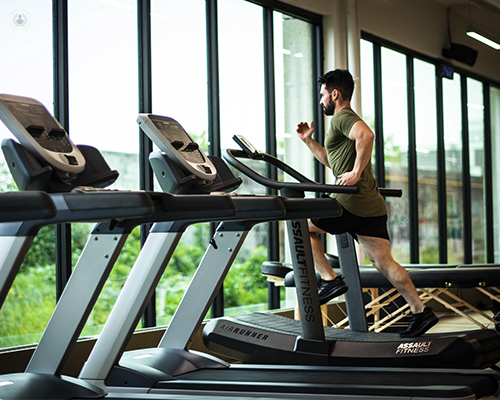Exercise testing
Autore:An exercise test evaluates how your heart copes with physical exertion. Learn from a leading consultant cardiologist, Dr Sukhjinder Nijjer, about what precisely this test does; the conditions it can detect and evaluate; how long the test lasts and who benefits from it.

What is an exercise tolerance test?
An exercise test is a medical test in which you walk and then run on a treadmill while having continuous ECG (electrocardiograph) monitoring. This machine monitors your heart’s electrical activity.
Small electrodes (sticky patches) will be attached to your chest and an inflatable cuff will be placed around your arm to measure your blood pressure every 2-3 minutes. You will stand on a treadmill, very similar to those seen in modern gyms, and you will move through a series of exercise stages. The treadmill will increase in speed and steepness every 3 minutes. It will start very gently to get you used to do doing the test. By stage 3, a brisk walk is needed and by stage 4 a jog is usually required. Depending on your fitness, stage 6 is typically a fast run.
You will be supported by an exercise physiologist who will ensure your safety throughout every stage of the test. We perform these tests in medical environments with full emergency treatment available and, at One Heart Clinic, a cardiologist is always nearby to ensure your safety.
What symptoms or potential conditions is it looking out for?
Exercise testing is performed for a variety of reasons. Key symptoms that may lead a cardiologist to request one are chest pains, breathlessness on exertion, palpitations or if there is a history of hypertension ( high blood pressure).
The main reasons to perform an exercise stress test are to assess for symptoms on exertion, look for ECG changes that reflect angina (which is a lack of blood supply to the heart) or signs of arrhythmia (abnormal heartbeats) that are causing palpitations. Exercise stress testing is also often helpful in patients who have had previous stents or bypass surgery as a means to assess their exercise capacity.
In some patients, it is not always clear if their symptoms are related to the heart and exercise stress testing. When combined with other sensitive tests, exercise testing is a very safe and helpful way of assessing their symptoms. Over the years, there has been a lot of research data that shows an individual’s capacity on an exercise test reflects their longer-term prognosis.
Who is most likely to need this test?
Some special patient groups are more likely to need an exercise stress test. Those who work in certain jobs where safety-critical responsibilities can require stress testing as part of their annual assessments. Jobs such as taxi, bus and train drivers often need these tests if they have had heart problems in the past. Aeroplane pilots and motor racing licences may also require exercise testing.
How do you prepare for the test?
It’s important to wear comfortable clothing and shoes that will allow you to run. Professional training shoes are not necessary but wearing something comfortable and well fitted is important. Consider bringing a change of clothes, particularly if you tend to sweat a lot during exercise. We recommend avoiding caffeine for 4 hours before the test and avoid a heavy meal.
The key to a high-quality exercise stress test is to achieve the maximum target heart rate. In younger people, this can be more challenging but the test is designed to become progressively harder so even very fit people will reach their calculated peak heart rate. In those who take medications that limit their heart rate, such as patients with angina who take beta-blockers, it’s important to stop the medication 48 hours before the test. Example beta-blockers include bisoprolol, carvedilol, metoprolol and atenolol.
Before we undertake an ETT, we may need to undertake an echocardiogram to ensure the heart structure is normal. This is a non-invasive ultrasound scan of the heart and it’ important if there are murmurs when we listen with a stethoscope; some heart valve problems mean we need to take extra care during exercise.
When we do exercise testing, we often have to shave chest hair to ensure we have a high-quality ECG tracing.
How long does it last?
An exercise test requires approximately ten minutes of setting up before the test begins. You will need to sign a consent form to confirm that you understand what the test involves and appreciate the small risk associated with undertaking a stress test. Once the test begins, its duration will depend on your exercise capacity and if there are any changes on the ECG or blood pressure test. In some cases, there may be changes that mean the test is terminated early. The average individual will do between 8 and 12 minutes on the treadmill. Once the test is over, the treadmill is slowed down and we will observe your recovery. Once your heart rate has returned to a state similar to before the exercise, then we will remove the monitoring equipment and allow you to return to the waiting room. The average exercise test is 30 minutes in total - from beginning to end.
You must tell the physiologist whether you are having any symptoms and if you would prefer to stop while you are exercising. In some patients, you may tire due to your joints or legs and this should be noted. You can choose to stop the test at any time.
Who can take the treadmill stress test?
Almost all people who can walk quickly on the flat or an incline can undertake an exercise test. Patients with physical limitations due to back, knee or hip issues may prefer to consider other tests instead of a treadmill. Patients with certain cardiac conditions should only undertake an exercise test under close supervision. These conditions include severe aortic stenosis and hypertrophic cardiomyopathy. Exercise testing can certainly be performed but additional caution is wise.
When do you get the results?
The results of an exercise test are typically available immediately. The results can be seen by the physiologist but a detailed interpretation will be by given by your consultant cardiologist alongside all the other information about your health and cardiac condition.
If you’re having doubts about your cardiac health, don’t hesitate to see a specialist. Get in touch with Dr Sukhjinder Nijjer by visiting his profile.


